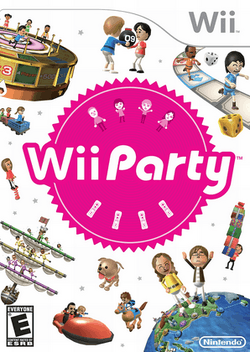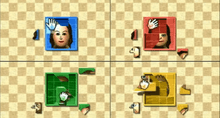Wii Party
| Wii Party | |
|---|---|
 | |
| Developer(s) |
Nd Cube Nintendo SPD Group No.4 |
| Publisher(s) | Nintendo |
| Director(s) | Shuichiro Nishiya |
| Producer(s) |
Atsushi Ikeda Hiroshi Sato |
| Composer(s) | Ryo Nagamatsu |
| Series | Wii |
| Platform(s) | Wii |
| Release date(s) | |
| Genre(s) | Party |
| Mode(s) | Single-player, multiplayer |
Wii Party (Wiiパーティ Wī Pāti) is a party video game developed and published by Nintendo for the Wii video game console.[4] The game heavily borrows game play elements from the Mario Party series, another Nintendo franchise. It is also the first game in the Wii series that Shigeru Miyamoto did not produce.[5] The game was released in Japan on July 8, 2010,[1] in North America on October 3, 2010, in Australia on October 7, 2010, and in Europe on October 8, 2010. Wii Party was first revealed by Satoru Iwata in a Financial Results Briefing on May 7, 2010.[6] It has met with mixed reviews from critics and sold 9.24 million copies worldwide as of September 2016.[7] A sequel, Wii Party U, was released for the Wii U on October 25, 2013.
Gameplay

Wii Party features 9 different game modes divided between three categories: Party Games, House Party Games, and Pair Games. Most of the game modes integrate use of Wii Party's 80 mini-games. The game also offers additional modes that make exclusive use of the mini-games.
Party Games
Party Games are games in which four players compete against one another. In all party games except Spin-Off if the minigame ends in a tie, a die roll decides.
- Board Game Island
A player roll dice(s) and proceeds the indicated number of steps (Mii characters are used as players' game pieces). The order players roll the dice each round is decided by a minigame. Players who come in first, second or third win a bonus die to roll along with the standard die. The player who reaches the top of the island first wins.
- Globe Trot
Players turn over numbered cards and move the indicated number of spaces. Players win coins in minigames (1st = 10, 2nd = 5, 3rd = 3, 4th = 1) that can be used to purchase vehicle cards to help them advance, or at airports and seaports to travel long distances. When players reach a hot spot, they can purchase a souvenir photo for 10 coins. After 10 rounds, overtime begins and the first player to reach a hot spot and take a souvenir photo ends the game. The player who has collected the most souvenir photos and coins at that point wins.
- Swap Meet/Mii of a Kind
Players take turns choosing a Mii from the middle to swap out with a Mii from their area. Players who collect three Mii characters with the same-colored outfits in two different rows win points (various bonuses are possible depending on how Mii characters are matched, so the points players will receive also varies). The player who has the most points after a set number of rounds is the winner.
- Spin-Off
Players take turns spinning a wheel to earn medals. Depending on where the wheel stops, players can win medals, lose medals, or add medals to the bank. Players can also win medals saved up in the bank by winning minigames. (If 2 or 3 players tied, the players split the bank. If all the players tie, nothing happens.) After 10 rounds, overtime begins, and the game ends after somebody wins a Bank Battle, or 10 more rounds. The player with the most medals wins.
- Bingo
Players check off Mii characters on their bingo cards that match Mii balls that drop from the bingo machine. If a minigame ball drops from the bingo machine, players play a minigame and the winner checks off a Mii of his or her choice. (If there are 2 or more winners, a die roll decides.) The first player to complete a horizontal, vertical, or diagonal row gets a bingo and is the winner.
Pair Games
Pair Games are designed for play with only two players, either cooperatively or competitively.
- Friend Connection
The 2 real players answer questions. After 5 questions are answered, the players play a minigame to test if the players are a good pair or a bad pair. The starter Miis for the best pair are Matt and Lucia (70) while the starter Miis for the worst pair are Tatsuaki and Abby (26).
- Balance Boat
Players balance Mii characters while matching the outfits. Balancing 20 Miis wins the game. If the boat tips over, the Miis will fall into the water, and the players will have to start again.
- Match-Up
Players match up Mii characters wearing the same-colored shirts into pairs to score points (players don’t know what color the Mii characters’ shirts are until they select them). If players fail to match up a pair, they lose a heart. If players lose all of their hearts, they lose a turn. The player with the most points at the end of the game is the winner!
House Party
House Party Games are activities that focus on the players' environments. One of the games (Quick Draw) was included only in the Japanese version.
- Hide and Hunt
Find the Wii Remote for a period. In every 10 seconds, the Wii Remote makes a sound.
- Time Bomb
Players pass the Wii Remote gently while holding specified buttons. Don't shake the Wii Remote too much or the bomb will explode.
- Word Bomb
Say a word that matches a category and pass the bomb.
Buddy Quiz
Players predict the response of a "buddy" and get points for predicting correctly.
Minigame modes
- Free Play
Play any minigame.
- Battle
Players win a set of minigames.
- Challenge
Puzzle minigames.
- Solo
A one player minigame quest
- Spot the Sneak/Rule Reversal
Players play minigames by earning points and take points from a cheater.
Development
After the development of Mario Party 8, several of Hudson Soft's key designers left to work for Nintendo subsidiary Nd Cube.[8] Wii Party was first revealed to the public by Satoru Iwata during a presentation to investors at E3 2010 on May 7, 2010.[6] In an Interview on Iwata Asks, Nd Cube said that "One of the attractions of Mario Party is that you can play with your favorite character", but they "thought that using Mii characters would strengthen the impression that you yourself are playing together with your friends." Iwata also hoped "people will play Wii Party for years to come as the new standard in party game software."[9]
Reception
| Reception | ||||||||||||||||||||||||
|---|---|---|---|---|---|---|---|---|---|---|---|---|---|---|---|---|---|---|---|---|---|---|---|---|
| ||||||||||||||||||||||||
Wii Party received a mixed reception, with an average Metacritic score of 68/100.[11] GameSpot awarded Wii Party a score of 8 out of 10, praising the wide variety of games and modes. GameSpot also added that the game's multiplayer "is a blast," and believes that Wii Party is "faster and better" than Mario Party.[15] Nintendo World Report also gave the game an 8/10, citing that "A common complaint about Mario Party is that it has too many things that slow gameplay down to a near halt, such as multiple traps on one game board and waiting for the player to finish his or her turn. Wii Party avoids this by speeding up gameplay".[18] IGN gave the game a 7/10, criticizing the graphics saying, despite being bright and colorful, that they are "not exactly pretty", but praised Nintendo for doing a good job to allow players to follow instructions to get through objectives.[17] GameTrailers gave the game a 7.9, saying "Aside from a few dud modes and some minor control issues, there isn't a whole lot to fault."[16]
Phil Kollar of Game Informer stated in a negative review that "Wii Party's 80-plus minigames share the same uneven quality I've come to expect from Mario Party, which makes sense given that many of them are iterations of games from that series. The metagames are even worse. Whereas Mario Party gave players multiple boards to play through, Wii Party features multiple game types, each less exciting than the last."[14]
Sales
In its first week of release in Japan, Wii Party sold 230,000 units and was the country's best-selling game that week.[19] As of October 5, 2010, Wii Party has sold 1,350,791 units in Japan.[20] The game has sold 9.24 million copies worldwide as of September 2016.[7]
See also
References
- 1 2 Wii Party release date. Nintendo Official Magazine. 2 June 2010.
- ↑ "Gamescom: Kirby, Donkey Kong Release Dates Announced". IGN. 17 August 2010. Retrieved 17 August 2010.
- ↑ "Make your Wii the life and soul of the party!". Nintendo. 11 August 2010. Retrieved 11 August 2010.
- ↑ Ronaghan, Neal. Nintendo Reveals Wii Party. Nintendo World Report. 7 May 2010.
- ↑ Iwata Asks: Wii Party, Page 3
- 1 2 "Financial Results Briefing for Fiscal Year Ended March 2010: May 7, 2010 Presentation by Satoru Iwata, President". Nintendo Co., Ltd. Retrieved 2011-07-08.
- 1 2 "Top Selling Software Sales Units". Nintendo. 2016-03-31. Retrieved 2016-04-27.
- ↑ "What Wii Party And Mario Party Have In Common". Kotaku. Retrieved 2010-08-26.
- ↑ Wii.com - Iwata Asks: Wii Party
- ↑ "Wii Party for Wii". GameRankings. Retrieved 20 November 2010.
- 1 2 "Wii Party". Metacritic. 5 October 2010. Retrieved 21 June 2011.
- ↑ "Wii Party Review". 1UP.com. 5 October 2010. Retrieved 20 November 2010.
- ↑ Christian Donlan (6 October 2010). "Wii Party Wii Review". Eurogamer. Retrieved 20 November 2010.
- 1 2 Phil Kollar (3 October 2010). "For The Love Of God, Don't RSVP To This Party". Game Informer. Retrieved 20 November 2010.
- 1 2 "Wii Party Review for Wii". GameSpot. 1 October 2010. Retrieved 1 October 2010.
- 1 2 "Wii Party: Review, Trailers, and Interviews". GameTrailers. 6 October 2010. Retrieved 20 November 2010.
- 1 2 "IGN's Wii Party Review for Nintendo Wii". IGN. 3 October 2010. Retrieved 5 October 2010.
- ↑ "Nintendo World Report:Wii Party Review". Nintendo World Report. 30 September 2010. Retrieved 3 October 2010.
- ↑ "Wii Party Rocks Japan". Gawker Media. 18 July 2010. Retrieved 18 July 2010.
- ↑ "Media Create Sales: September 20 to 26". Nintendo World Report. 1 October 2010. Retrieved 1 October 2010.
External links
| Wikimedia Commons has media related to Wii Party. |
- Official Wii Party website (United States)
- Official Wii Party website (Japanese)
